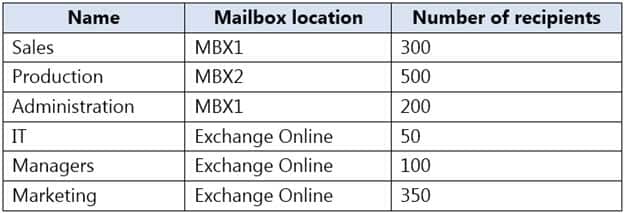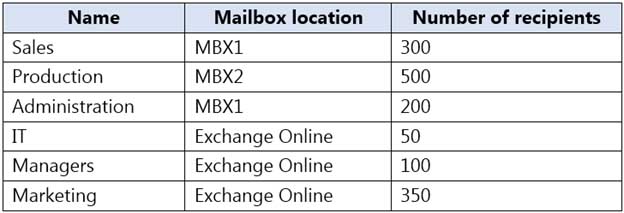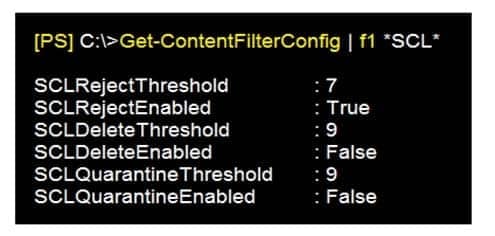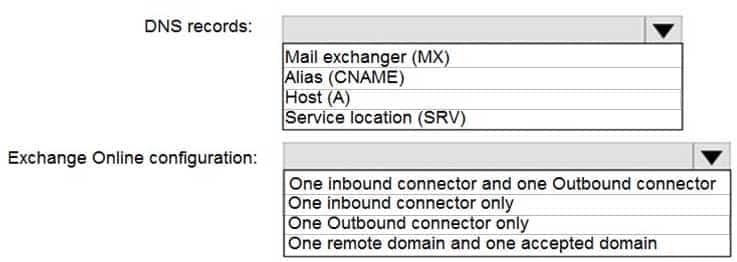MS-203 : Microsoft 365 Messaging : Part 09
MS-203 : Microsoft 365 Messaging : Part 09
-
Note: This question is part of a series of questions that present the same scenario. Each question in the series contains a unique solution that might meet the stated goals. Some question sets might have more than one correct solution, while others might not have a correct solution.
After you answer a question in this section, you will NOT be able to return to it. As a result, these questions will not appear in the review screen.
Your company has a Microsoft Exchange Server 2019 hybrid deployment that contains two Mailbox servers named MBX1 and MBX2.
The company has the departments shown in the following table.

MS-203 Microsoft 365 Messaging Part 09 Q01 111 From the on-premises organization, outbound email is sent directly to the Internet by using DNS lookups.
You are informed that some sales department users send email messages that are identified as spam.
You need to automatically block the sales department users from repeatedly sending spam.
Solution: You run the Install-Antispam Agents.psl PowerShell script on the MBX1 Mailbox server.
Does this meet the goal?
- Yes
- No
-
Note: This question is part of a series of questions that present the same scenario. Each question in the series contains a unique solution that might meet the stated goals. Some question sets might have more than one correct solution, while others might not have a correct solution.
After you answer a question in this section, you will NOT be able to return to it. As a result, these questions will not appear in the review screen.
Your company has a Microsoft Exchange Server 2019 hybrid deployment that contains two Mailbox servers named MBX1 and MBX2.
The company has the departments shown in the following table.

MS-203 Microsoft 365 Messaging Part 09 Q02 112 From the on-premises organization, outbound email is sent directly to the Internet by using DNS lookups.
You are informed that some sales department users send email messages that are identified as spam.
You need to automatically block the sales department users from repeatedly sending spam.
Solution: You migrate all the mailboxes of the sales department to Exchange Online.
Does this meet the goal?
- Yes
- No
Explanation:
Exchange Online Protection (EOP) will scan outbound messages from Exchange Online mailboxes. -
Note: This question is part of a series of questions that present the same scenario. Each question in the series contains a unique solution that might meet the stated goals. Some question sets might have more than one correct solution, while others might not have a correct solution.
After you answer a question in this section, you will NOT be able to return to it. As a result, these questions will not appear in the review screen.
Your company has a Microsoft Exchange Server 2019 hybrid deployment that contains two Mailbox servers named MBX1 and MBX2.
The company has the departments shown in the following table.

MS-203 Microsoft 365 Messaging Part 09 Q03 113 From the on-premises organization, outbound email is sent directly to the Internet by using DNS lookups.
You are informed that some sales department users send email messages that are identified as spam.
You need to automatically block the sales department users from repeatedly sending spam.
Solution: You modify the outbound spam filter policy in Exchange Online.
Does this meet the goal?
- Yes
- No
Explanation:
From the on-premises organization, outbound email is sent directly to the Internet by using DNS lookups. Therefore, the Exchange Online outbound spam filter will not scan the emails sent from the on-premises mailboxes. -
HOTSPOT
You are evaluating the email hygiene configuration of a Microsoft Exchange Server 2019 organization.
You run the command shown in the following exhibit.

MS-203 Microsoft 365 Messaging Part 09 Q04 114 Use the drop-down menus to select the answer choice that completes each statement based on the information presented in the graphic.
NOTE: Each correct selection is worth one point.

MS-203 Microsoft 365 Messaging Part 09 Q04 115 Question 
MS-203 Microsoft 365 Messaging Part 09 Q04 115 Answer -
HOTSPOT
You have a Microsoft Exchange Online tenant.
You plan to filter all inbound and outbound email messages by using a third-party message hygiene solution.
You need to ensure that all the email sent and received by the tenant is filtered through the message hygiene solution. The solution must ensure that only the message hygiene solution can send email to the tenant.
What should you configure for the tenant? To answer, select the appropriate options in the answer area.
NOTE: Each correct selection is worth one point.

MS-203 Microsoft 365 Messaging Part 09 Q05 116 Question 
MS-203 Microsoft 365 Messaging Part 09 Q05 116 Answer -
HOTSPOT
You have an Exchange Online tenant that has the anti-spam settings configured as shown in the following exhibit.

MS-203 Microsoft 365 Messaging Part 09 Q06 117 Use the drop-down menus to select the answer choice that completes each statement based on the information presented in the graphic.
NOTE: Each correct selection is worth one point.

MS-203 Microsoft 365 Messaging Part 09 Q06 118 Question 
MS-203 Microsoft 365 Messaging Part 09 Q06 118 Answer -
Note: This question is part of a series of questions that present the same scenario. Each question in the series contains a unique solution that might meet the stated goals. Some question sets might have more than one correct solution, while others might not have a correct solution.
After you answer a question in this section, you will NOT be able to return to it. As a result, these questions will not appear in the review screen.
Your company has a Microsoft 365 subscription.
Several users in the finance department of the company recently accessed unsafe websites by clicking on links in email messages.
Users in the marketing department of the company report that they must be able to access all the links embedded in email messages.
You need to reduce the likelihood of the finance department users accessing unsafe websites. The solution must affect only the finance department users.
Solution: You modify the content filtering settings.
Does this meet the goal?
- Yes
- No
-
Note: This question is part of a series of questions that present the same scenario. Each question in the series contains a unique solution that might meet the stated goals. Some question sets might have more than one correct solution, while others might not have a correct solution.
After you answer a question in this section, you will NOT be able to return to it. As a result, these questions will not appear in the review screen.
Your company has a Microsoft 365 subscription.
Several users in the finance department of the company recently accessed unsafe websites by clicking on links in email messages.
Users in the marketing department of the company report that they must be able to access all the links embedded in email messages.
You need to reduce the likelihood of the finance department users accessing unsafe websites. The solution must affect only the finance department users.
Solution: You create a new safe attachments policy.
Does this meet the goal?
- Yes
- No
-
Note: This question is part of a series of questions that present the same scenario. Each question in the series contains a unique solution that might meet the stated goals. Some question sets might have more than one correct solution, while others might not have a correct solution.
After you answer a question in this section, you will NOT be able to return to it. As a result, these questions will not appear in the review screen.
Your company has a Microsoft 365 subscription.
Several users in the finance department of the company recently accessed unsafe websites by clicking on links in email messages.
Users in the marketing department of the company report that they must be able to access all the links embedded in email messages.
You need to reduce the likelihood of the finance department users accessing unsafe websites. The solution must affect only the finance department users.
Solution: You create a new safe links policy and apply the policy to finance department users.
Does this meet the goal?
- Yes
- No
-
Note: This question is part of a series of questions that present the same scenario. Each question in the series contains a unique solution that might meet the stated goals. Some question sets might have more than one correct solution, while others might not have a correct solution.
After you answer a question in this section, you will NOT be able to return to it. As a result, these questions will not appear in the review screen.
You have a Microsoft Exchange Server 2019 hybrid deployment. All user mailboxes are hosted in Microsoft 365. All outbound SMTP email is routed through the on-premises Exchange organization.
A corporate security policy requires that you must prevent credit card numbers from being sent to internet recipients by using email.
You need to configure the deployment to meet the security policy requirement.
Solution: From Microsoft 365, you create a data loss prevention (DLP) policy.
Does this meet the goal?
- Yes
- No
-
Note: This question is part of a series of questions that present the same scenario. Each question in the series contains a unique solution that might meet the stated goals. Some question sets might have more than one correct solution, while others might not have a correct solution.
After you answer a question in this section, you will NOT be able to return to it. As a result, these questions will not appear in the review screen.
You have a Microsoft Exchange Server 2019 hybrid deployment. All user mailboxes are hosted in Microsoft 365. All outbound SMTP email is routed through the on-premises Exchange organization.
A corporate security policy requires that you must prevent credit card numbers from being sent to internet recipients by using email.
You need to configure the deployment to meet the security policy requirement.
Solution: From the Exchange organization, you create a data loss prevention (DLP) policy.
Does this meet the goal?
- Yes
- No
-
Note: This question is part of a series of questions that present the same scenario. Each question in the series contains a unique solution that might meet the stated goals. Some question sets might have more than one correct solution, while others might not have a correct solution.
After you answer a question in this section, you will NOT be able to return to it. As a result, these questions will not appear in the review screen.
You have a Microsoft Exchange Server 2019 hybrid deployment. All user mailboxes are hosted in Microsoft 365. All outbound SMTP email is routed through the on-premises Exchange organization.
A corporate security policy requires that you must prevent credit card numbers from being sent to internet recipients by using email.
You need to configure the deployment to meet the security policy requirement.
Solution: From the Exchange organization, you modify the properties of the Send connectors.
Does this meet the goal?
- Yes
- No
Explanation:
You should create a Data Loss Prevention (DLP) policy. -
You have a Microsoft Exchange Server 2019 organization.
You need to ensure that a user named User1 can prevent mailbox content from being deleted if the content contains the words Fabrikam and Confidential.
What should you do?
- Add User1 to the Discovery Management management role group.
- Add User1 to the Security Administrator role group.
- Add User1 to the Records Management management role group.
- Add User1 to the Compliance Management management role group.
Explanation:
The Legal Hold management role is required to place a mailbox on Litigation Hold or In-Place Hold. But to create a query-based In-Place Hold, you must also be assigned the Mailbox Search role. Users that have been added to the Discovery Management role-based access control (RBAC) role group (or assigned the Legal Hold and Mailbox Search roles) can place users hold and create a query-based In-Place Hold. -
DRAG DROP
Your company has a Microsoft Exchange Server 2019 hybrid deployment.
The company has two departments that have the mailboxes configured as shown in the following table.

MS-203 Microsoft 365 Messaging Part 09 Q14 119 All the accounting department mailboxes reside in a database named ACCT-DB01.
You create the mailboxes shown in the following table.

MS-203 Microsoft 365 Messaging Part 09 Q14 120 You need to record all the email communication of the users in each department. The solution must minimize costs.
What should you use for each department? To answer, drag the appropriate options to the correct departments. Each option may be used once, more than once, or not at all. You may need to drag the split bar between panes or scroll to view content.
NOTE: Each correct selection is worth one point.

MS-203 Microsoft 365 Messaging Part 09 Q14 121 Question 
MS-203 Microsoft 365 Messaging Part 09 Q14 121 Answer -
You have an Exchange Online tenant that contains several hundred mailboxes.
Several users report that email messages from an SMTP domain named @fabrikam.com often fail to be delivered to their mailbox.
You need to increase the likelihood that the email messages from the @fabrikam.com domain are delivered successfully to the users in the tenant.
What should you do?
- From your public DNS zone, create a Sender Policy Framework (SPF) TXT record.
- From the Microsoft 365 security center, modify the anti-spam policy settings.
- From the Microsoft 365 security center, modify the DKIM settings.
- From the Microsoft 365 security center, create a new ATP anti-phishing policy.
-
You have a Microsoft Exchange Server 2019 organization.
You run the following commands.

MS-203 Microsoft 365 Messaging Part 09 Q16 122 You have a user named Admin1.You need to ensure that Admin1 can manage the mailboxes of users in the Executives organizational unit (OU) only.What should you do?
- Modify the membership of VIP Admins.
- Add Admin1 to the Recipient Management management role group.
- Move Admin1 to the Executives OU.
- Create a custom role group.
-
HOTSPOT
Your company has a Microsoft Exchange Server 2019 hybrid deployment.
The company has four departments that have the mailboxes shown in the following table.

MS-203 Microsoft 365 Messaging Part 09 Q17 123 The mailboxes are configured as shown in the following table.

MS-203 Microsoft 365 Messaging Part 09 Q17 124 You have two administrators named Admin1 and Admin2 that are assigned the permissions shown in the following table.

MS-203 Microsoft 365 Messaging Part 09 Q17 125 For each of the following statements, select Yes if the statement is true. Otherwise, select No.
NOTE: Each correct selection is worth one point.

MS-203 Microsoft 365 Messaging Part 09 Q17 126 Question 
MS-203 Microsoft 365 Messaging Part 09 Q17 126 Answer -
You have a Microsoft 365 environment that contains 1,000 mailboxes.
You need to ensure that only an administrator named Admin1 can use the Exchange Management Shell to manage Exchange Online settings.
What should you do?
- For Admin1, run the Set-User cmdlet and specify the -RemotePowerShellEnabled parameter.
- Create a conditional access policy and apply the policy to all users.
- Create a conditional access policy and apply the policy to Admin1.
- For all users, run the Set-User cmdlet and specify the -RemotePowerShellEnabled parameter.
-
You have a Microsoft Exchange Online tenant that has Office 365 Advanced Threat Protection (ATP) enabled.
The tenant contains a user named Ben Smith who has a UPN of ben.smith@fabrikam.com. Ben Smith is protected by using an ATP anti-phishing policy.
Ben Smith reports that emails sent from his personal account of ben.smith@relecloud.com are not delivered to his work email account.
You need to ensure that personal emails are delivered to the ben.smith@fabrikam.com account.
What should you do?
- Create a transport rule to assign the MS-Exchange-Organization-PhishThresholdLevel header a value of 2 for the messages received from ben.smith@relecloud.com.
- Add ben.smith@fabrikam.com as a trusted sender to the ATP anti-phishing policy.
- Add ben.smith@relecloud.com as a trusted sender to the ATP anti-phishing policy.
- Add relecloud.com to the ATP anti-phishing list of trusted domains.
-
You have a Microsoft Exchange Server 2016 hybrid deployment.
You plan to migrate mailboxes from the on-premises Exchange organization to Exchange Online.
You have the appropriate permissions to perform the mailbox migrations.
You need to prepare the environment for the planned migration.
What should you do?
- Enable the MRSProxy service on an on-premises Exchange server.
- Install the Hybrid Agent.
- Run Get-MigrationBatch -Identity “MyMigrationBatch”.
- Disable Microsoft Outlook for the web.